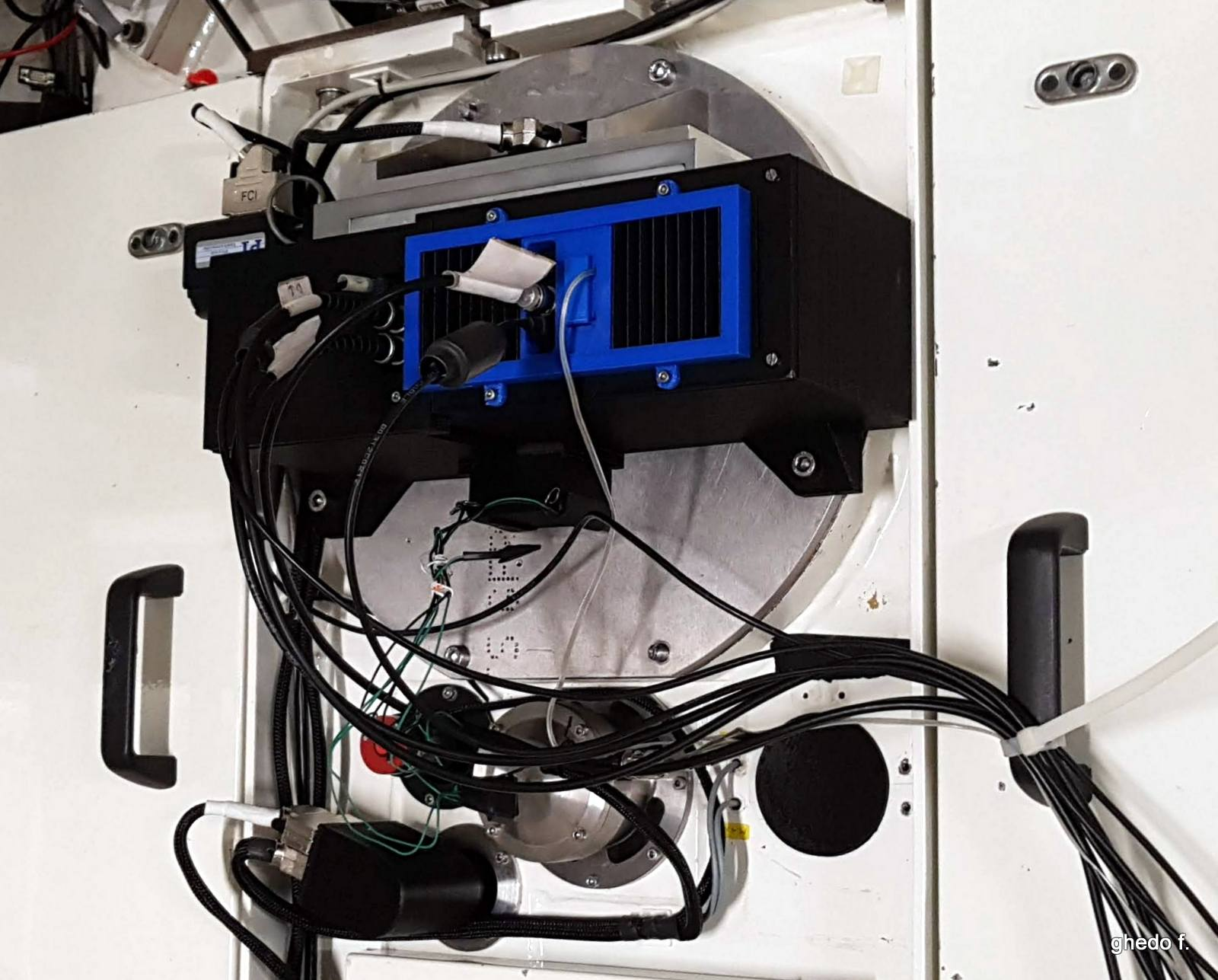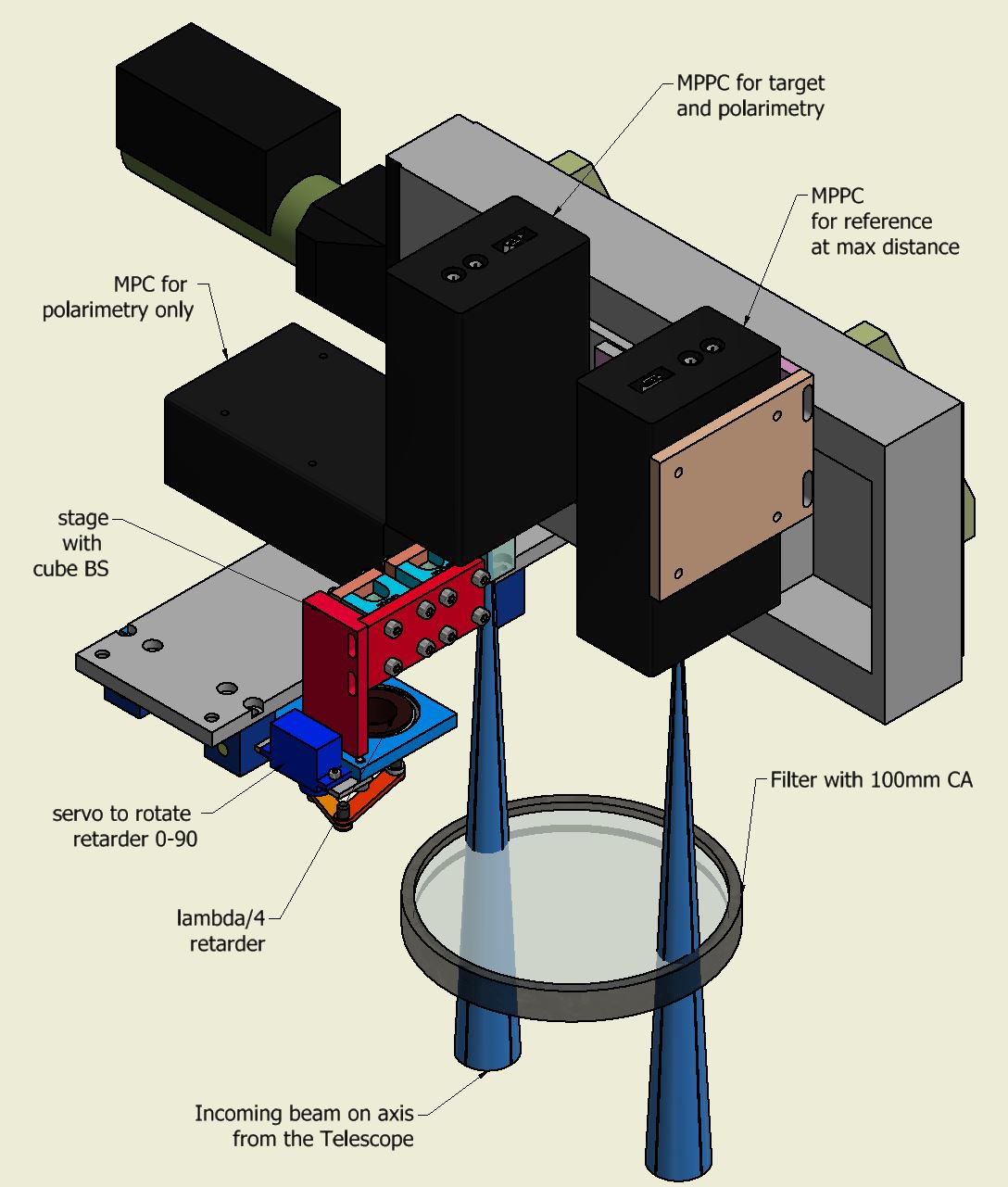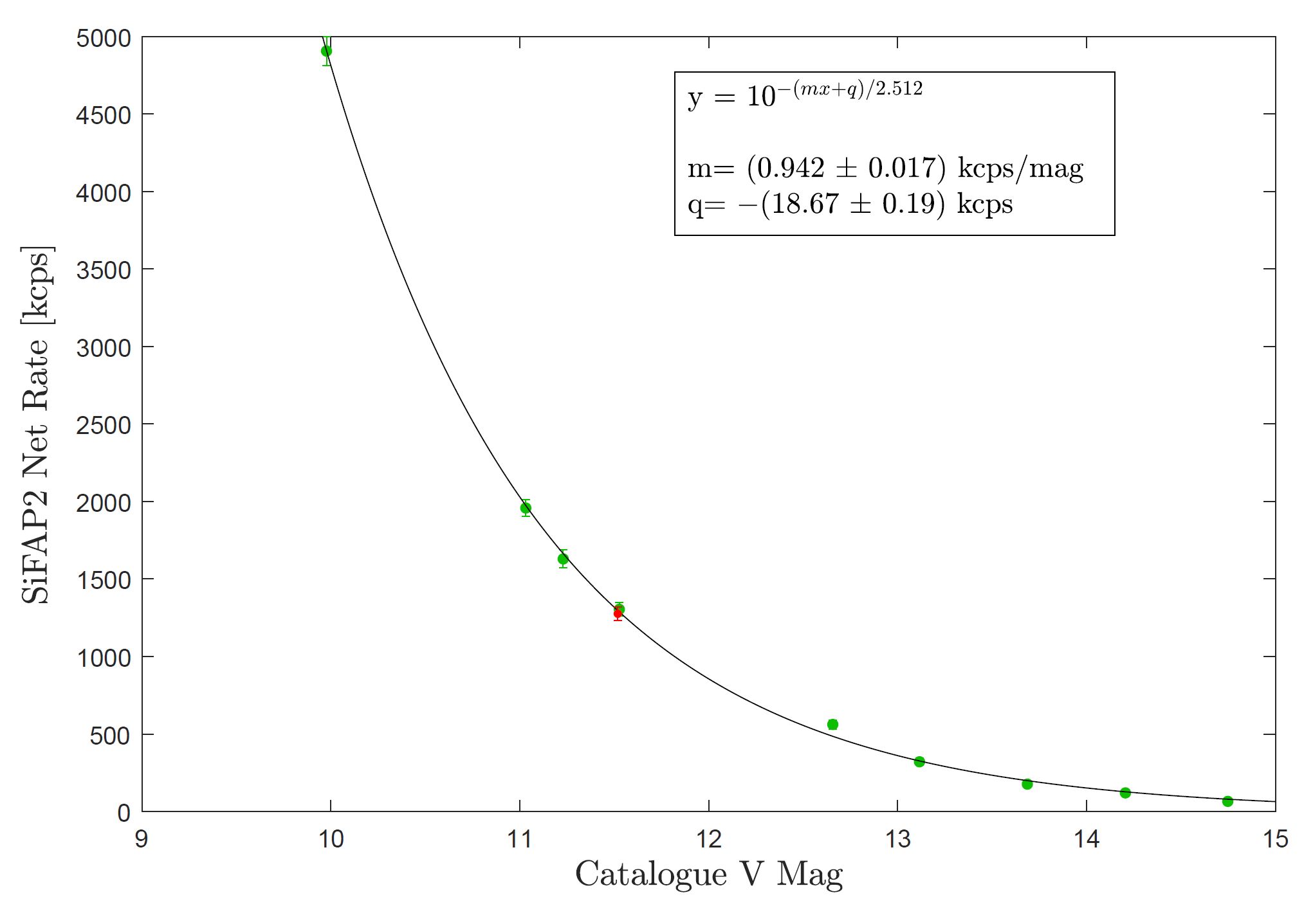Telescope & Instruments
SiFAP2: Silicon Fast Astronomical Photometer and Polarimeter
SiFAP2 is an extremely fast photometer based on Hamamatsu MPPC bi-dimensional silicon photo-multiplier, with a custom readout electronic system built in Università La Sapienza (Rome) capable to tag single photons with a time resolution of 8 nanoseconds. The absolute timing is provided by a commercial GPS system with an accuracy better than 60 microseconds with respect to the UTC (Universal Time Coordinated).
SiFAP2 is the opto-mechanically improved version of SiFAP (html; pdf) with added polarimetric capabilities.

Figure1: SiFAP2 is mounted at the F/11 direct focus on the Nasmyth Interface
For the next semester of April/September 2021 SiFAP2 will be offered as PI instrument. Please refer to the Call for Observing time if you wish to submit a proposal. [link to the call]
For more information about the instrument please refer to the Reference.
For the scientific results obtained with SiFAP and SiFAP2 please refer to the References.

The Detectors
SiFAP2 uses HAMAMATSU MPPCs (Multi Pixel Photon Counters) detectors, composed of a bidimensional matrix of SPADs (Single Photon Avalanche Diodes) with overall linear dimension of ~1.3x1.3mm2. It has a photon counting capability rather than providing an image of the source. The plate scale at the F/11 focal plane is 0.187mm/arcsec, which means approximately ~7 x 7 arcsec2 of FoV. The Target detector is mounted on-axis, at the center of the FoV, while the Reference detector is displaced from the Target at a defined distance, depending on the on-sky separation between target and reference star.
Photon efficiency

Figure 3: Typical Photon efficiency of a MPPC
Expected counts

Figure 4: Best fitting curve for net count rates of standard K0V-K5V stars observed with SiFAP2 in white light (no filter applied) as a function of catalogue V mag. Objects were observed at small Zenith distances therefore the correction for the air mass is negligible. The red point, representing a G0V star, has not been taken into account for the fitting procedure.
Resume of Main Characteristics of SiFAP2
| Acquiring mode: | Time Tag, Gated mode |
| Absolute timing accuracy: | < 60 µs |
| Relative time resolution *: | 8 ns (Time Tag), 1 ms (Gated Mode) |
| Field of View: | 7 arcsec x 7 arcsec |
| Bandpass: | 320 - 900 nm (peaked @ 450 nm with 40% efficiency, @900 nm 5% efficiency) |
| Linearity: | < 10 Mcps (detector saturation @ 15 Mcps) |
| Count rate/Vmag: | kcps |
| Maximum storing count rate: | < 2Mcps for Time Tag (otherwise throughput saturation) < 15 Mcps for Gated Mode (otherwise detector saturation) |
* The relative time accuracy suffers from a clock drift which is well modelled and then corrected by means of a linear function of time. The thermal component of the drift can be instead safely neglected being five orders of magnitude smaller than the clock period.
Observing modes
The most used observing mode is the simple photometry when light is simultaneously collected by the Target and the Reference detectors. In this configuration the light arrives on the detectors directly from the telescope. A broadband filter can be inserted to select the observing wavelength. The reference star is needed “as reference”, to check for variability of flux due to changes in the transparency of the sky, for clouds, dust, airmass, etc. It is also useful for checking the tracking and guiding accuracy of the telescope.
The other observing mode is linear polarimetry. A polarizing cube beam splitter is inserted before the Target Detector and splits the two polarized states between this and the Folded detector. They have conjugated planes so they see the same object but in two different polarization states. A lambda/2 retarder before the cube BS can be rotated to the predefined angles of [0 , 22.5, 45, 67.5] degrees. The focus shift due to the presence of the cube and of the retarder is taken into account by the system and compensated with a displacement of the secondary mirror of the TNG.
Circular polarimetry is also available by substituting the retarder with a lambda/4 one. The systems need to be re-calibrated. (Please NOTE that this option is NOT offered during next call).
Reference Position Constraints
The separation between the Reference star and the Target is limited by the opto-mechanics of the instrument. The
User
shall find a suitable reference with magnitude similar to the target and a distance from the latter within the
range
of (210, 480) arcsecs.
Min distance to target = 210 arcsec
Max distance from target = 480 arcsec
The minimum is determined by the physical dimensions of the detectors; the maximum by the available FoV.
The Position Angle of the reference in the sky is calculated N→ E and is added as an offset from the position angle of SiFAP2. SiFAP2 Position Angle with 0 offsets places the Reference at north of target.
Example of target/reference relative positions
Target: Crab pulsar
Reference: 2MASS J05340719+2200294
| alpha [hh][mm][ss] |
delta [deg][']["] |
|
|---|---|---|
| Target coordinates | 05:34:31.94 | +22:00:52.2 |
| Reference coordinates | 05:34:07.194 | +22:00:29.48 |
| Separation in arcsec | 344.88 | |
| Convert distance in mm | 64.49 | |
| Derotator position angle | SiFAP2 + 266.203 |
Filters
A set of 8 broad band filters is available in front of the detectors and the selected filter covers both the target and reference. The filters are part of the Dolores filters sets[link filter_page]. An empty position for white light photometry is also available (“CLEAR”).
| Filter Name | FW [deg] |
|---|---|
| U Johnson | 125 |
| V Johnson | 197 |
| R Johnson | 233 |
| B Johnson | 269 |
| r sloan | 17 |
| i' sloan | 53 |
| u sloan | 89 |
| g sloan | 305 |
| CLEAR | 161 |
The focus shift due to the presence of the filter is taken into account by the system and corrected with the displacement of the TNG secondary mirror.
The whole set of narrow band filters available for Dolores is also available for SiFAP2 but it is usually not installed. In case of special observative conditions which require the use of narrow band filters, the swap between filters must be organized in advance with the PI of the Instrument.
Preparing Observations
The user will prepare an ASCII txt catalogue with the following format:
Targ_name, Targ Alpha, Targ Delta, Targ Vmag, Ref Alpha, Ref Delta, Ref Vmag, Obs Mode (PHOtometry, POLarimetry)
Crab_PSR,05:34:31.94,+22:00:52.2,M_Vt,05:34:07.194,+22:00:29.48,M_Vr,PHO
Crab_PSR,05:34:31.94,+22:00:52.2,M_Vt,0,0,0,0,POL
If the reference is not necessary, or if observing in Polarimetry, its values can be substituted with 0.
Data Output
The data will be pre-reduced and given to the observer in FITS file format with the time tag of detected photons and their multiplicity.
References
- SiFAP: A New Fast Astronomical Photometer The Tenth International Workshop on Multifrequency Behaviour of High Energy Cosmic Sources, Palermo, Italy, 2013. Acta Polytechnica CTU Proceedings 1, p.311,Nov 2014 [DOI: 10.14311/APP.2014.01.0311]
- The Latest Version of SiFAP: Beyond Microsecond Time Scale Photometry of Variable Objects, Journal of Astronomical Instrumentation Vol. 05, No. 03 , Sep. 2016 [DOI: 10.1142/S2251171716500057]
- Fast multichannel astronomical photometer based on silicon photo multipliers mounted at the Telescopio Nazionale Galileo, Proceedings of the SPIE, Volume 9147, (2014).[DOI: 10.1117/12.2064649]
- SiFAP: High Speed Photometry for variable sources in the Optical band, 42nd COSPAR Scientific Assembly. Held 14-22 July 2018, in Pasadena, California, USA, Abstract id. E1.3-20-18.
- SIFAP2: a new versatile configuration at the TNG for the MPPC based photometer, Proceedings of the SPIE, Vol. 10702, (2018).[DOI: 10.1117/12.2316348]
- Optical pulsations from a transitional millisecond pulsar, Nat.Ast., Volume 1, p. 854, Oct. 2017 [DOI:10.1038/s41550-017-0266-2]
- Pulsating in Unison at Optical and X-Ray Energies: Simultaneous High Time Resolution Observations of the Transitional Millisecond Pulsar PSR J1023+0038, The Astrophysical Journal, p. 104, Vol. 882, (2019). [DOI: 10.3847/1538-4357/ab2fdf]

